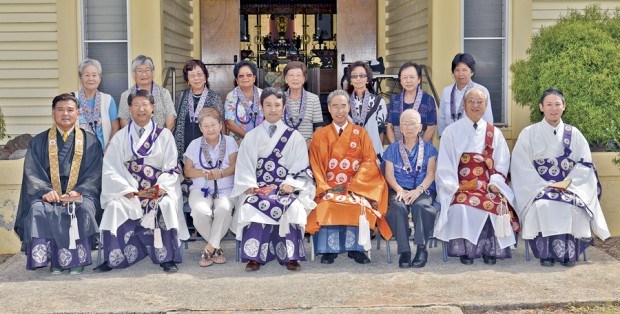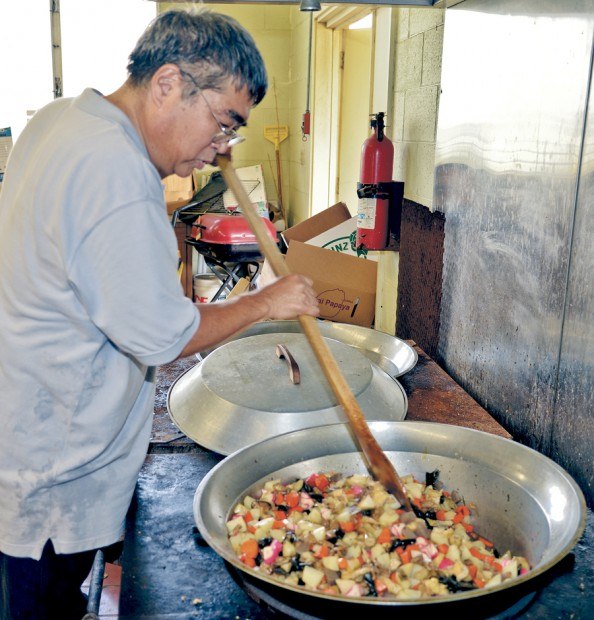KAPA‘A — The women were active at least 10 years before the church was established, said Alton Miyamoto, president of the Honpa Hongwanji Mission of Hawai‘i. Members of the Kapa‘a Hongwanji Mission Buddhist Women’s Association, with Thelma Doi as its
KAPA‘A — The women were active at least 10 years before the church was established, said Alton Miyamoto, president of the Honpa Hongwanji Mission of Hawai‘i.
Members of the Kapa‘a Hongwanji Mission Buddhist Women’s Association, with Thelma Doi as its president, were honored and celebrated during a commemoration service on Sunday, which was attended by Bishop Eric Matsumoto of the Honpa Hongwanji Mission and a number of diginitaries, including previous ministers of the Kapa‘a Hongwanji Mission.
“The Buddhist women’s movement had its humble beginning in 1898 in Honolulu,” Miyamoto, a Westside resident, said in a letter to the two-day celebration. “The movement quickly spread throughout the Islands and the women of the Kapa‘a Fukyo-jo organized in 1912, 10 years before the Kapa‘a Hongwanji was established.”
Miyamoto said women have been dedicated and loyal supporters of the temple because it offers a place where people with common goals can meet for religious purposes as well as education and cultural activities.
“Many women members of the BWA gave selflessly,” said Clyde Takekuma, president of the Kapa‘a Hongwanji Mission. “You have shown us how to live the Jodo Shinshu teachings and serve as an integral organization of this temple and the other Honpa Hongwanji of Hawai‘i temples.”
In 1912, the Fujinkai of the Kapa‘a Fukyo-jo, or branch temple of the Kealia Hongwanji from 1910 to 1912, was formed, the women working as a group, no one taking responsibility of an officer’s position, to assist in the religious and social activities of the temple, according to the group.
The majority of the women were Japanese speaking and are credited with the preservation and continuation of the traditional rituals of the major services conducted at the temple.
Many of the donations of Fujinkai members are currently being used in the Kapa‘a Hongwanji Mission, including the lacquered table at the head of the aisle, the incense burner, the large stand on the top level of the altar, which held the largest floral arrangement, the podium used by the service emcee, the tables gracing both sides of the alter, the first “Uchishiki” and the first piano.
“These women have played an essential role in the preservation of religious services and social activities on the island,” said Mayor Bernard Carvalho Jr. in a congratulatory letter. “I think it’s wonderful that their hard work and dedication are being recognized.”
The first temple of the Kapa‘a Hongwanji Mission was built on land leased from the County of Kaua‘i in 1922 and served the community until it was destroyed by fire in 1929.
Three parcels of land were purchased from the Territory of Hawai‘i in 1938 leading to the construction of a new temple and the Young Buddhists of America hall.
Coming on the heels of the construction of the language school classroom, World War II broke out in 1941. Rev. Hironori Nishie was sent to a relocation camp on the Mainland and Jihei Miura was elected to care for the Butsudan while the facilities were used by the U.S. Army as officers’ headquarters.
In 1950, the Kapa‘a Hongwanji Wakokai was established, the group composed mostly of the younger English-speaking women, and its formation spearheaded by Chieno Masuda and Kayo Tsuchiya.
Wakokai members annually hosted fundraising food and rummage sales, the proceeds donated toward the purchase of an organ for the temple, and in 1955, the kitchen wing, which adjoined the language school classroom, was built through the effort of the group.
According to WBA history, the Wakokai furnished the kitchen with a stove and an oven, and also donated funds to purchase kitchen wares. They also sponsored both the Girl Scouts and the Brownie Troop, which eventually became the most active in the community.
“Traditionally, women have always been in a support role as the ones to cook, clean up and make home and hospital visitations,” Miyamoto said. “Over the generations, the role has evolved where women are now involved with Project Dana, student exchange programs, cultural programs, community service and participation, educational programs and more.”
Miyamoto said there are many physical reminders of the women’s generosity and dedication through the donations they made and are an integral part of the temple. More importantly, women are taking more active leadership roles in local and statewide organizations.
Due to lack of participation, the Wakokai became inactive in 1980, the majority of the members joining the Fujinkai and continued their assistance with temple activities.
Over the years, the group has undergone several name changes to the current BWA, affiliated with the Kaua‘i United Honpa Hongwanji BWA and the Hawai‘i Federation of BWA.
There are approximately 18 active and 11 associate members of the Kapa‘a Hongwanji BWA, a large percentage of the members being 80 years and old and are unable to participate.
“Although today, the Kapa‘a Hongwanji BWA is small in numbers, they continue to uphold many of the rituals and traditions and have classes, choir and fundraising for scholarships,” said Janet Honda, president of the Hawai‘i Federation of BWA. “As we continue into the 21st century, our faith remains steadfast, but as our population ages, so does the decline in membership. Decreasing membership is a serious concern to the Hawai‘i Federation BWA organization. We need to take active steps to increase and sustain our membership, statewide.”
Rev. Kazunori Takahashi said the temple’s columbarium was refurbished for the Women’s Association Centennial.
“This project was highly significant in the sense that we could express our deep respect and gratitude to our predecessors,” Takahashi said. “Now, we must pass on to the next generation what we have received from the past members.”
Brian Yamamoto, a Kapa‘a Hongwanji Mission member, was busy at the wok, stirring in the final ingredients of the nishime, a Japanese stew dish, as the commemoration service for the BWA would down.
“One thing about the women’s organization, is they taught me how to cook,” Yamamoto said.



